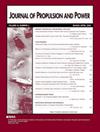利用纳秒重复脉冲等离子体控制大振幅燃烧振荡
IF 2.4
4区 工程技术
Q2 ENGINEERING, AEROSPACE
引用次数: 1
摘要
本文详细介绍了使用纳秒重复脉冲放电来减弱14kw旋流稳定甲烷/空气燃烧器的燃烧不稳定性。高速化学发光表明,燃烧室表现出平均压力的1% ~ 4%的大振幅压力振荡,在此期间,火焰在每个不稳定循环中,上游和下游都表现出大块运动。控制是通过一个电极完成的,该电极包括位于燃烧器中心线的一个引脚阳极,允许在靠近火焰基部的区域产生纳秒级的火花,通过旋转流的剪切层,并在金属燃烧器壁上结束。放电使用20kv, 9khz脉冲产生;它们对应的平均功率约为120w。这导致压力振荡的峰值幅度被抑制了2到4倍,有效值为5 dB。利用有等离子体和没有等离子体时火焰的相位平均可视化,我们详细描述了不稳定过程中火焰运动的顺序。随着等离子体的活跃,这揭示了在抑制过程中火焰和等离子体之间的显著相互作用。最后,我们提出了热声系统的状态空间模型,并演示了不稳定性的开环控制。本文章由计算机程序翻译,如有差异,请以英文原文为准。
Control of Large-Amplitude Combustion Oscillations Using Nanosecond Repetitively Pulsed Plasmas
This paper details the use of nanosecond repetitively pulsed discharges to attenuate combustion instabilities in a 14 kW swirl-stabilized methane/air combustor. The combustor exhibits large-amplitude pressure oscillations ranging from 1 to 4% of the mean pressure during which the flame exhibits bulk motion in each instability cycle, upstream and downstream, as revealed by high-speed chemiluminescence. Control is accomplished with an electrode comprising a pin anode at the centerline of the combustor, allowing a nanosecond spark to be generated in a region spanning close to the flame base, through the shear layers of the swirling flow and ending at the metallic combustor wall. The discharges are generated using 20 kV, 9 kHz pulses; and they correspond to about 120 W of mean power. This results in a suppression of the peak amplitude of the pressure oscillations by a factor of two to four, and 5 dB in the rms value. Using phase-averaged visualizations of the flame with and without plasma, we detail the sequence of flame motion in the course of the instability. With the plasma active, this reveals significant interactions between the flame and the plasma during the suppression. Finally, we present a state-space model of the thermoacoustic system, and we demonstrate open-loop control of the instabilities.
求助全文
通过发布文献求助,成功后即可免费获取论文全文。
去求助
来源期刊

Journal of Propulsion and Power
工程技术-工程:宇航
CiteScore
4.20
自引率
21.10%
发文量
97
审稿时长
6.5 months
期刊介绍:
This Journal is devoted to the advancement of the science and technology of aerospace propulsion and power through the dissemination of original archival papers contributing to advancements in airbreathing, electric, and advanced propulsion; solid and liquid rockets; fuels and propellants; power generation and conversion for aerospace vehicles; and the application of aerospace science and technology to terrestrial energy devices and systems. It is intended to provide readers of the Journal, with primary interests in propulsion and power, access to papers spanning the range from research through development to applications. Papers in these disciplines and the sciences of combustion, fluid mechanics, and solid mechanics as directly related to propulsion and power are solicited.
 求助内容:
求助内容: 应助结果提醒方式:
应助结果提醒方式:


